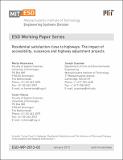| dc.description.abstract | In this paper we focus on gaining insight into the residential satisfaction of households near highways, based on survey data collected among 1,225 respondents in the Netherlands living within 1,000 meters from a highway. Ordinal regression was used to study the impact of highway externalities on residential satisfaction. Moreover, we gained first insights into the reactions of people on highway adjustment projects, by studying people’s expectations towards residential satisfaction as a consequence of the project with use of a multinomial logistic regression analysis.
On average, 85 percent of respondents reported being satisfied with living near a highway. Regarding explanatory characteristics, subjective evaluations of air and noise nuisance and of accessibility are of comparable importance and seem to outperform objective exposure calculations or distance from the highway or access lane in explaining residential satisfaction. Moreover highway interest is directly reflected in a higher satisfaction. However, other factors such as neighborhood design, traffic safety and social cohesion are important as well. People react differently to highway adjustment plans, negative expectations being highly driven by current negative feelings towards nuisance, and positive expectations by personal interest in accessibility and a positive attitude towards cars.
An important implication could be the notion that exposure is not the same as perceived nuisance, which may give reason to be cautious when making transportation planning decisions based solely on calculations. In addition, the finding that other (neighborhood) factors are also very important in explaining residential satisfaction is interesting when thinking about compensating for the negative effects of a highway in the neighborhood. Also, the results regarding reactions to an announced highway adjustment project might be used to better adjust the planning process to the characteristics of the residents in the area. Further research is necessary to deepen the results, for example through the addition of other road project locations, interviews and longitudinal data. | en_US |
